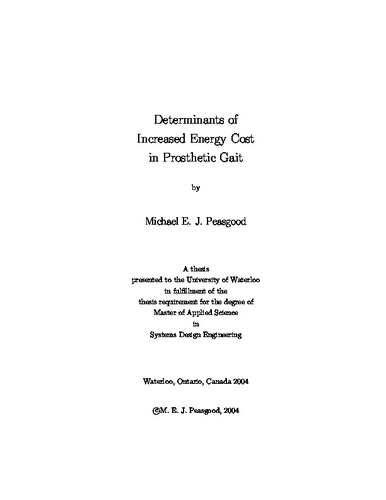| dc.contributor.author | Peasgood, Michael | en |
| dc.date.accessioned | 2006-08-22 14:01:49 (GMT) | |
| dc.date.available | 2006-08-22 14:01:49 (GMT) | |
| dc.date.issued | 2004 | en |
| dc.date.submitted | 2004 | en |
| dc.identifier.uri | http://hdl.handle.net/10012/880 | |
| dc.description.abstract | The physiological energy requirements of prosthetic gait in lower-limb amputees have been observed to be significantly greater than those for able-bodied subjects. However, existing models of energy flow in walking have not been very successful in explaining the reasons for this additional energy cost. Existing mechanical models fail to capture all of the components of energy cost involved in human walking. In this thesis, a new model is developed that estimates the physiological cost of walking for an able-bodied individual; the same cost of walking is then computed using a variation of the model that represents a bi-lateral below-knee amputee. The results indicate a higher physiological cost for the amputee model, suggesting that the model more accurately represents the relative metabolic costs of able-bodied and amputee walking gait. The model is based on a two-dimensional multi-body mechanical model that computes the joint torques required for a specified pattern of joint kinematics. In contrast to other models, the mechanical model includes a balance controller component that dynamically maintains the stability of the model during the walking simulation. This allows for analysis of many consecutive steps, and includes in the metabolic cost estimation the energy required to maintain balance. A muscle stress based calculation is used to determine the optimal muscle force distribution required to achieve the joint torques computed by the mechanical model. This calculation is also used as a measure of the metabolic energy cost of the walking simulation. Finally, an optimization algorithm is applied to the joint kinematic patterns to find the optimal walking motion for the model. This approach allows the simulation to find the most energy efficient gait for the model, mimicking the natural human tendency to walk with the most efficient stride length and speed. | en |
| dc.format | application/pdf | en |
| dc.format.extent | 1832871 bytes | |
| dc.format.mimetype | application/pdf | |
| dc.language.iso | en | en |
| dc.publisher | University of Waterloo | en |
| dc.rights | Copyright: 2004,
Peasgood, Michael. All rights reserved. | en |
| dc.subject | Systems Design | en |
| dc.subject | walking | en |
| dc.subject | gait | en |
| dc.subject | metabolic energy | en |
| dc.subject | mechanical model | en |
| dc.subject | balance control | en |
| dc.subject | prosthetic | en |
| dc.subject | amputee | en |
| dc.title | Determinants of Increased Energy Cost in Prosthetic Gait | en |
| dc.type | Master Thesis | en |
| dc.pending | false | en |
| uws-etd.degree.department | Systems Design Engineering | en |
| uws-etd.degree | Master of Applied Science | en |
| uws.typeOfResource | Text | en |
| uws.peerReviewStatus | Unreviewed | en |
| uws.scholarLevel | Graduate | en |

